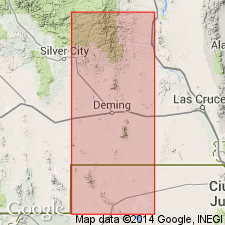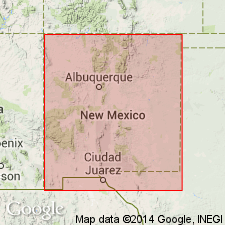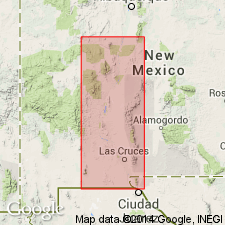
- Usage in publication:
-
- Thoroughgood formation
- Modifications:
-
- First used
- Dominant lithology:
-
- Sand
- Silt
- AAPG geologic province:
-
- Orogrande basin
Summary:
First[?] published use of name. Intent to name, derivation of geographic name, and designation of a type not stated. Consists of 12 ft of interbedded sand and silt. Only the thinning edge is present in Rhodes Canyon [in the San Andres Mountains, Sierra Co, NM in the Orogrande basin] where it overlies Contadero Formation and underlies Rhodes Canyon Formation. Assigned to the Devonian. Shaly interbeds comprise the "fish zone and the SPIRIFER zone" of Stevenson.
Source: GNU records (USGS DDS-6; Denver GNULEX).

- Usage in publication:
-
- Thoroughgood Formation*
- Modifications:
-
- Areal extent
- Overview
- AAPG geologic province:
-
- Orogrande basin
Summary:
Type section stated to be on Sheep Mountain northern San Andres Mountains of Sierra Co. Present on Sheep Mountain in San Andres Mountains, Sierra and Dona Ana Cos., NM in the Orogrande basin where it overlies Contadero Formation and underlies Rhodes Canyon Formation. Thin remnants present in Rhodes Canyon and Deadman Canyon in central part of the San Andres. Has not been identified elsewhere in south-central NM. Cephalopod and gastropod, as a small brachiopod assemblage (listed) identified. Nine genera and 11 species of brachiopods present. Probably equivalent to Ready Pay Member of Percha Shale. Is of early Famennian age. Cross sections. Correlation charts.
Source: GNU records (USGS DDS-6; Denver GNULEX).

- Usage in publication:
-
- Thurgood Sandstone Member
- Modifications:
-
- Revised
- Areal extent
- Overview
- AAPG geologic province:
-
- Orogrande basin
Summary:
Spelling and rank of stratigraphic name changed from Thoroughgood Formation to Thurgood Member, middle member of Contadero Formation. Spelling change conforms to earliest use of place name on a geologic map and to modern usage by the USGS. History of place name given. Is present throughout the northern San Andres Mountains from Cottonwood Canyon to north side of Sheep Mountain, Sierra Co, NM in Orogrande basin. Deposited on an erosional surface at top of underlying Salinas Peak Member (new) of Contadero. Underlies the Rhodes Canyon Member (reduced in stratigraphic rank) of Contadero. Ranges in thickness from 1.2 m at Mackinson and Cottonwood Canyons to 3.7 m at Sly Gap, its type. Consists of several resistant, well-indurated, calcareous, well-sorted sandstone beds. Phosphatic pebbles at several levels. Burrowing common. Brachiopod fragments scattered throughout. Brachiopod and conodont fossils of early Fammenian, Late Devonian age. Is equivalent to Ready Pay Member of Percha Formation. Cross section; nomenclature chart; geologic map.
Source: GNU records (USGS DDS-6; Denver GNULEX).
For more information, please contact Nancy Stamm, Geologic Names Committee Secretary.
Asterisk (*) indicates published by U.S. Geological Survey authors.
"No current usage" (†) implies that a name has been abandoned or has fallen into disuse. Former usage and, if known, replacement name given in parentheses ( ).
Slash (/) indicates name conflicts with nomenclatural guidelines (CSN, 1933; ACSN, 1961, 1970; NACSN, 1983, 2005, 2021). May be explained within brackets ([ ]).

